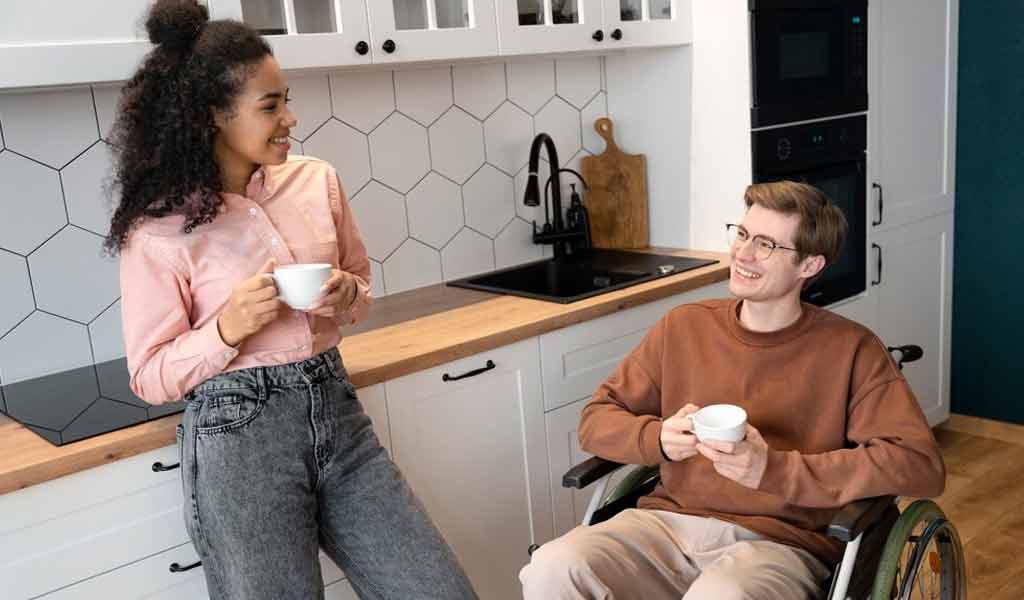An overview of supported independent living for NDIS participants who already have suitable accommodation
Supported independent living (SIL) is a type of support that may be available to eligible NDIS participants with higher support needs.
In most cases, SIL NDIS services are delivered in a share-house setting, sometimes referred to as a group home.
Many participants have very positive experiences and outcomes in shared SIL accommodation. However, for some people, an individual care arrangement in their own home (whether owned or rented) works best.
If you feel you need SIL supports but would prefer to receive care in your own home, we’ll explain how this might be possible in this article.
SeenCare is a specialist registered NDIS provider in Melbourne for people living with disability and high medical needs. We deliver a range of NDIS services to people living in their own homes, in our SIL houses and in specialist disability accommodation (SDA). If you would like to find out more about our services, please contact us today.
NDIS Change of Circumstances
The NDIS describes SIL support as being “for people with higher support needs, who need some level of help at home all the time.”
You don’t have to require help 24 hours a day to qualify for SIL funding. But, it is expected that SIL participants would need at least 8 hours of active person-person care every day.
The purpose of the SIL NDIS program is to help people with higher needs live as independently as possible, while building skills and pursuing their goals.
In most cases, one organisation will deliver the majority (or all) of a participant’s NDIS SIL care. The services provided are often called a roster of care (ROC).
What Supports Does SIL Cover?
NDIS SIL funding can include any supports you need to live independently and develop new skills in a home environment.
This could include things like:
- Help with household tasks, like cleaning and laundry
- Personal care, for things like showering and getting dressed
- Assistance with grocery shopping and cooking
- Support to get to appointments and access the community
- Developing new skills that can increase your independence
- General supervision to ensure safety, including overnight support
- Help to manage medications and health issues
Things Not Covered by SIL
While SIL NDIS funding is designed to help participants live independently in a home environment, it doesn’t cover general expenses related to maintaining a house.
Some of the things not covered by SIL are:
- Electricity, gas and other utilities
- Rent and mortgage payments
- Food and cleaning supplies
- House repairs and maintenance
- Supports covered by other NDIS funding categories, like transport or assistive technology
NDIS SIL Provider Staff
The average SIL organisation is primarily staffed by disability support workers. However, some SIL providers might employ staff with specialised skills, such as occupational therapists, physiotherapists, or mental health professionals.
integrated healthcare and disability supports
To enable us to deliver high-level integrated healthcare and disability supports, the SeenCare SIL NDIS team includes home nurses and bulk billing GPs, who work hand-in-hand with our experienced support workers.
Getting SIL Funding in Your Plan
While it shouldn’t stop you from trying to get SIL funding, it’s worth being aware that SIL is considered a high cost NDIS service. As a result, you will need to go through a bit of a process even after submitting your NDIS application to be considered for SIL.
To put things in perspective, in 2020, 6% of all NDIS participants were receiving SIL. Combined, the costs of these plans represented 30% of total NDIS funding!
Because eligibility for SIL funding NDIS can be tricky, we recommend getting advice from a support coordinator or LAC before applying. They will let you know whether SIL NDIS funding is likely to be granted in your situation, or if another type of funding might be better suited to your needs. They can also explain the assessment steps that will likely be required (including submitting a change of circumstances if needed) to prove your eligibility.
Shared SIL Accommodation
The majority of participants with NDIS SIL funding live in shared accommodation.
This might be in a group home type setting, where the SIL provider delivers services in a property they manage. Or, it could also be in the home of a participant who receives SIL funding and has decided to share their housing and supports with another person.
The benefits of SIL NDIS supports in shared accommodation include:
- Easier to arrange 24/7 care, as participants can potentially share support workers (eg., 1 support worker supporting 2 participants)
- Increased social interaction, which can help ease loneliness and provide opportunities to build social skills
- Participants with high needs can live in a small homely environment (say, a shared house, with 2-4 other residents) rather than a larger hostel or facility with dorm style rooms
SIL NDIS Services in Your Own Home
Despite the potential benefits, shared NDIS SIL services aren’t right for everyone.
There might be a specific personal or health issue for why you prefer to live alone. Or, perhaps there are no SIL vacancies in your area and moving somewhere else would cut you off from family supports. You also might just prefer to live alone (but be prepared, without any other justification this might not be enough to get your SIL application approved).
If you and your support team are confident SIL support is the best way to meet your needs and a shared living arrangement is not suitable, explain why in your application or planning meeting.
To give yourself the best chance of success, be as clear as possible about the reasons why shared SIL NDIS services would not be ideal for pursuing your goals.
Tips for Making a Successful Application
Our top tips for getting SIL NDIS funding for a non-shared living arrangement are:
- Provide evidence for any medical, psychological or social reasons that make a solo-living environment better for you than shared
- Explain how the supports you are asking for can meet all your needs (to avoid the suggestion that you pool funds with other participants to maximise your care)
- Avoid providing reasoning along the lines of, “I just prefer to live alone.” That may well be true, but NDIS funding decisions are made on the basis of support needs
- If possible, have your accommodation organised already. This could be a home you own, a rental property or a vacancy with a SIL provider who is willing to accommodate you on your own in their property
- Remain open to other suggestions, as during discussions you may uncover an alternative support arrangement that would suit you just as well as SIL
A Pathway Toward Independence and Freedom
For many participants with high support needs, SIL NDIS services can provide a way to achieve a level of independence and freedom that isn’t available through other avenues.
While in most cases NDIS SIL funding is only approved for shared living arrangements, in some circumstances, it can also be provided to people living alone in their own homes.
If you think receiving SIL support to live in your own home is the best way to achieve your goals, the first step is to talk to your support coordinator or LAC. They can give you specific advice relevant to your situation and help you make an application if you decide that’s the right choice.
For NDIS participants living in Melbourne who already have SIL funding, SeenCare can deliver supports in your own home or in one of our SIL properties. We’re experts at supporting people with complex care needs, including co-occurring disability and medical needs. To find out more, contact us today.












